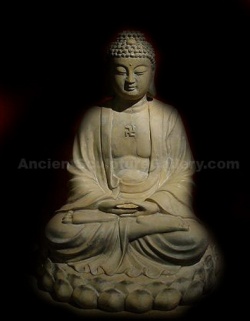How did Buddhism enter China?
Buddhism entered China, in any noticeable fashion, around the 3rd century AD through central Asia and then through Southeast Asia. There is an account that the Han emperor, Ming Ti, had an encounter with The Buddha in a dream in the 1st century and tried to propagate it China there after, yet, as a whole Buddhism did not gain any real foothold until the end of the Han dynasty. A few key factors in China gave Buddhism the extensive breeding ground it needed to flourish, even rivaling and later dwarfing the preexisting theologies that were native and well established in China from many centuries earlier. The shattered Han dynasty gave rise to many weak states that either could not resist Buddhism through force or were open-minded enough to allow its presence or even accept it. Buddhism's appeal to lay persons as a salvation practice as well as its accessibility to common folk interested in monastic life furthered its potency in China. Buddhism also appealed to intellectuals and elites, by way of assistance through legitimacy claims and other aid, or simple interaction with pure talk helped to solidify its position in China.
Buddhism spread in China quite rapidly at the end of the Han dynasty. Monks with translated Buddhist text, like Lokakshema, gave Buddhism an accessible quality to Chinese people helping it not seem foreign. Many Buddhist ideas melded with Daoism, like emptiness and vastness respectively, and the change of Buddhist no-self (anatman) with the idea of the soul being indestructible. Buddhism's Nirvana was looked at as immortality, a sought after ability in much of Chinese ideas and especially within Daoism. Buddhism used Daoist vernacular in its early translations to help its accessibility in China. Lao-tzu was even thought to be a reincarnation of The Buddha. Buddhism also worked with the Chinese customs to accommodate its new audience. Its early roots were often magical and worked well with many Daoist ideas. Later emphasis on filial piety and public assistance efforts, like helping people during a time of disaster as well as more common aid, continued Buddhism warm reception. The fluid ability of Buddhism really amalgamated much of Chinese customs and gave its self a home. Though Buddhism is foreign what it became it China was, in many ways, a native practice which is why it had such strong support in the dynasties after the Han. As the North steppe peoples received Buddhism from the trade routes of the tarim basin the nobles who fled the north China turmoil to the south meet Buddhism by way of its introduction through the southern travel and trade routes. From the Northern Wei rulers to the southern Wu, Buddhism found a new order ready to take on foreign concepts instead of resisting them.
As China spread its influence, as seen with the expansion into the Korean peninsula with the Lolang commanderies, Buddhism came with it. Buddhism grasp in China was so well rooted that it was able to affect Korean states like Koguryo who adopted Buddhism as the state religion in 372 AD. Maitreya's home land even became the kingdom of Silla. After this Buddhism continued to grow in Korean and this growth is how Buddhism found its place in the land of the rising sun (nihon) or to the Chinese Wa, Japan. Both of these non-sinitic eastern lands relied on writing, which they adopted from China, to further the state and Buddhism, which were at many times intertwined. As the Korean and Japanese connections with China continue so does the spread of sinitic ways and Buddhism. The symbiotic nature of Buddhism and the state grew in Korea and later in Japan in the same fashion as it did in China. Buddhism relied on state tolerance and patronage and in turn gave support to rulers through advice and the protection of the state and its people through magic.
Buddhism came first to Japan from Korea supposedly by monks dispatched from Paekche in the late 4th century. The Japanese fascination and admiration of Chinese culture readily absorbed Buddhism which was nearing its peak in China with the coming of the Sui and Tang dynasties. Much like in early China Buddhism meet at odds with the native faiths of Japan, in particular the (later named) Shinto practice. Buddhism did in some regard absorb some of the animistic outlook and deities and in turn contributed some as well. Buddhism, as it did in China and Korea, was soon seen as a protector of the state. The 7th century Prince Shotoku was considered a prominent supporter of Buddhism. Just as in China, as Buddhism grew the state began to sponsor and control it under the rule of Tenmu and his consort Jito. A great Buddhist temple, Todaiji (Great Eastern Temple), was built in Nara and was the national temple of the ruling state, and still remains a bastion of Buddhist history to this day.
Buddhism made a profound integration into East Asia. This is best reflected by the model of all other East Asian and even some central Asian civilization the Sui and especially Tang dynasties in China. Buddhism was the state religion of Sui and many Tang emperors supported Buddhism which was at its apex during the Tang period. The Buddhist monk under Tang rule was a subject or ch'en and much of Buddhism was regulated by the state. Ordination and legal status of monks was all overseen by the state, and monasteries (a great place for the wealthy to evade taxes by donations or land and such) were also under state control. During the Tang more and more Buddhist text were brought to China and then onto Korea and Japan. China had even begun to develop its own Buddhist scriptures. Just as the Chinese Monk, Xuanzan, under the assistance of the Tang emperor went to the west to gather more Buddhist knowledge, monks from further east like Ennin were venturing to China to embellish their knowledge of Buddhism. The expansion of the Tang Empire, coupled with the furthered protection of trade routes and relative peace between states, allowed the flourishing of Buddhism to continue its proliferation within and east of china. This compounded with the continued importation of Buddhist texts, merchants, and monks who expounded on earlier Buddhism and pushed it further into Chinese life and from there even further east.
Buddhism, though at first alien, is more at home in East Asia than its original home of India. Even by the time it was really taking root in China under the Tang, Buddhism was loosing its hold in India. Buddhism was the right practice in a time when China, under much political and social duress, looked for new ideas as a way to fix and/or distract from the situation at hand. Buddhism's ability to mold to its environment and its skillful means (upaya) of working to gain followers and supports at the expense of interpretation was the perfect fit for a fractured era. Buddhism continually shifted from being unnoticed by the state, to recognized, to part of it, then ruled with it, then subjugated, then persecuted; yet the lay support continued to grow in any of the cases. Though history is usually not recorded for or by the masses, Buddhism did take root, not just among the relative few elites interested in pure talk, or steppe rulers looking for legitimacy to their rule, not even for the first empress who was somehow the embodiment of Guanyin or Maitreya, but by the everyday worker as well. Some attribute this to Buddhism's appeal to an end of Suffering, a salvation, others give claim to the accessibly that a normal person could give up regular duties to become part of the Buddhist Sangha or just a devote lay supporter. Buddhism also had a lack of discrimination in class and practice (unlike Confucianism), though Buddhism prolific spread is defiantly attributed to all of these reasons and more, none the less Buddhism held on and spread on a monumentally impressive scale that shaped all of East Asia and still is shaping it today. --Interesting note as East Asia becomes more powerful and noticeable on an a scale of emulation by the west a large surge of Buddhism is acquainting itself with the west as well, not unlike the spread of Chinese civilization, including Buddhism, to Korea and Japan when they too where looking for a model. History is cyclical! ?"c'est la vie"?

